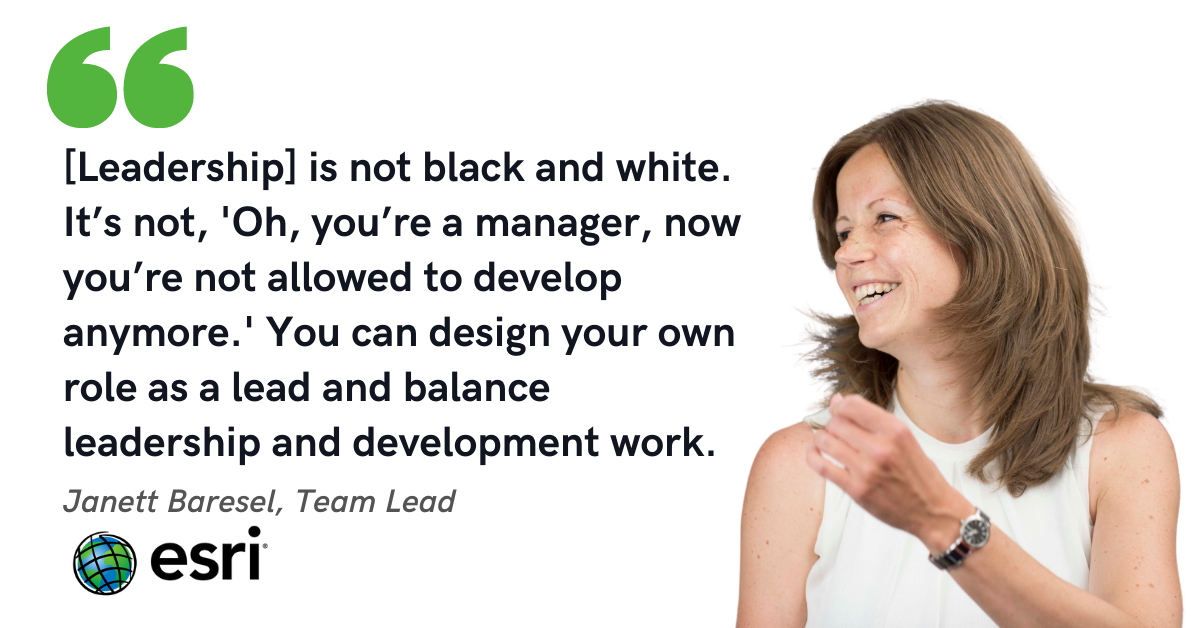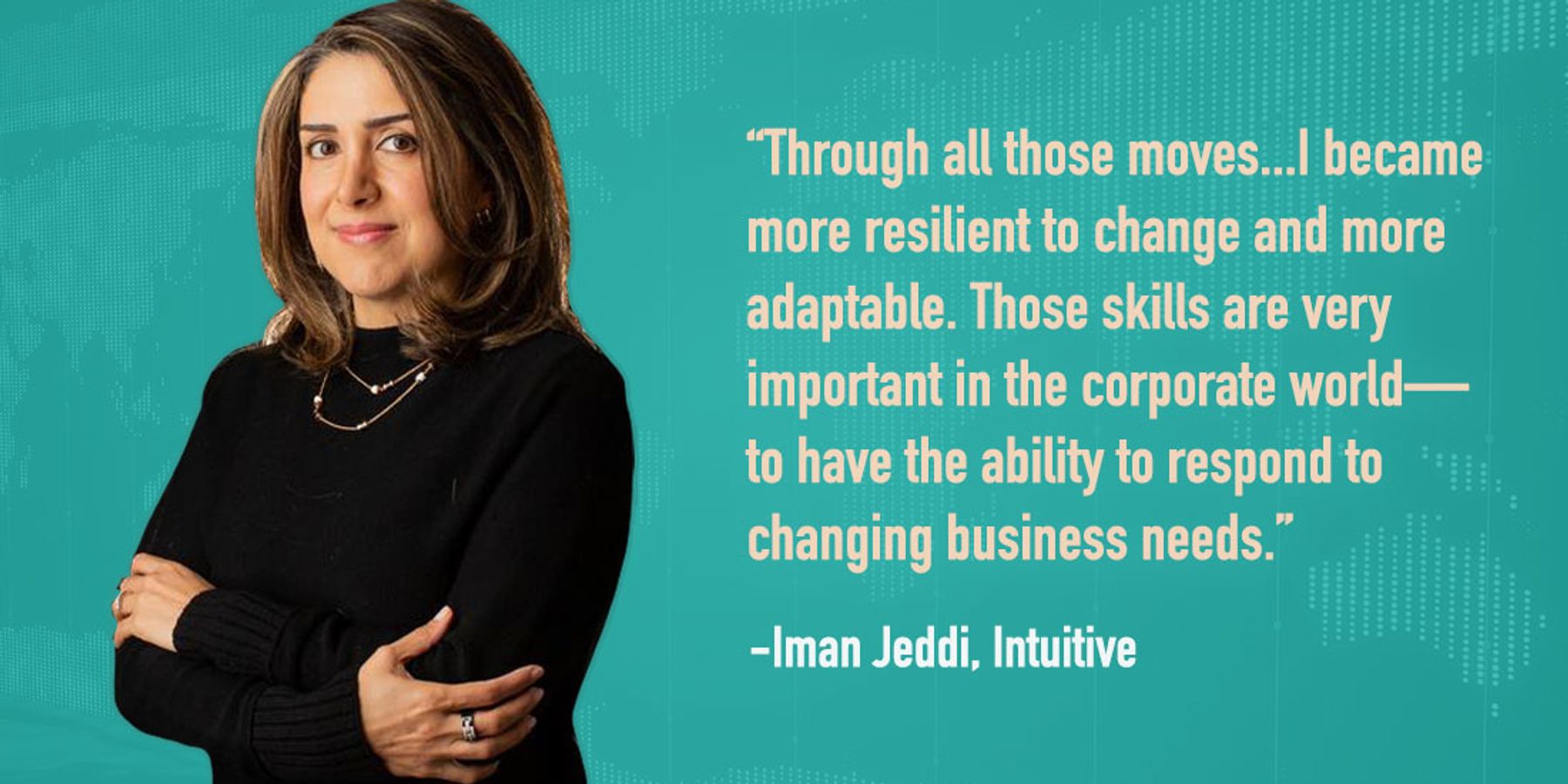When Janett Baresel did her team’s performance reviews as their manager for the first time, she wasn’t sure she’d be good at it.
And she told them so.
“I talked to them and said, ‘Look, I’m probably more nervous than you are.’ It was the first time I had to sit in front of them, and tell them what they do really well but also provide them with constructive feedback. It’s incredibly hard,” she says. “I think being open from the beginning helped.”
That’s part of going from an individual contributor role to a management role: expanding your skill set as you go, having to pick up new skills and figure out on the fly how to hone them.
Janett has done that throughout her career, first switching roles, then industries, and eventually countries, too, going from her native Germany to Australia to Switzerland. She now lives in Zurich and works as a Team Lead for geographic information system (GIS) tech company Esri.
We sat down with Janett to hear more about how she followed her passion to different roles, why she ended up at Esri, and how she’s embraced her latest transition into management—as well as what advice she has for other would-be managers considering making the same change.
Work that makes a difference
Janett has an older brother, and years of watching and joining him play computer games convinced her that she wanted to study in that field when she got to university. Exposure to a computer science course in high school—taught by a woman, to boot—only confirmed Janett’s commitment.
“I was good at math and tech. It's logical, I’m following certain syntax, certain rules,” she says. “But I also have a visual heart. I need a visual interface to understand a problem.”
Her unique interests and skills led Janett to choose computer graphics as her major. After graduating, she was faced with a choice: did she want to work in game development, movie animation, or GIS?
The first two weren’t particularly appealing to her. “If you work for movies, or the game industry, it doesn’t feel like you’re helping people solve a problem. It’s more entertainment,” she says. “I wanted to combine my 3D computer graphics interest with something that really helps people.”
While GIS was on the horizon, so was a move abroad. Janett had met her boyfriend while studying abroad in Australia, and she took a job in web development that came with a visa to return Down Under.
But after a few years, she and her partner were ready to move back to their native Europe and Janett started looking for her dream role: something in GIS that had a social impact angle.
When she found Esri, based in California but with offices around the globe, , she recognized the name. During her computer graphics studies Esri had popped up a couple of times.
Janett quickly learned how broad the field of GIS is, from complex forest mapping to visualizing data of bird migration across the globe, or planning out redevelopment projects for the city of Zurich. She applied—and was hired. Her family moved to Zurich, and she’s been with Esri ever since.
“Finding a company that does 3D applications and actually solves real problems with it in this world was a perfect combination,” says Janett. “It’s a very sustainable business, and a lot of people are passionate about climate change. This aligns very much with my values.”
Not a straight path
Janett started at Esri as a software engineer, and stayed in that role for about three years. Then she was promoted to a senior developer two months before going out on maternity leave.
“That was a great sign. They could have waited, right? They could've said, ‘Now she’s gone for half a year.’ For me, it showed me they liked what I was doing and wanted to reward me for it.”
As that team grew, Janett was asked to step into a team lead role, and it just made sense. She knew the people, she knew the work, and she found herself surprisingly passionate about coordinating projects and making things possible for her team.
She was able to step into management and feel confident, says Janett, because it was never billed as an all-or-nothing move.
“I talked to my colleagues, who were trying to motivate me to become team lead. They’d say, ‘It’s not black and white. It’s not, “Oh, you’re a manager, now you’re not allowed to develop or design anymore.” You do that, and it gives you a lot of decision power. You can design your own role as a lead and balance leadership and development work.,’” remembers Janett. “‘You’re not getting put into a box.’”
And it’s not just Janett who got that treatment, she says. She’s found the Esri leadership team in Zurich to be really thoughtful about what their employees want to do, and creative in finding the right opportunities for them to explore that.
“Our director [in Zurich] is awesome,” she says. “He’ll say, ‘You know, you’re valuable to us. What do you need? And can we find a place here that fits that?’”
Now, as a team lead, Janett is also the owner of her team’s product, which is a browser-based tool for visualizing 3D map data. She walks the balance between keeping her product simple and usable to really anyone, while also adding in complex functionality. Along the way, she works on developing her team and solving their problems—and giving them praise and constructive feedback in performance reviews.
4 tips for transitioning into management
Janett is upfront about the fact that she hasn’t formally studied management and that she’s learning on the job, along with the support she receives from Esri as a company that values ongoing learning and education for its employees. That being said, she’s gotten some pretty important lessons out of the last few years of firsthand experience, including:
- Communication is the most important part. And that rarely means telling other people what to do, says Janett. “It’s more support than it is being a teacher,” she says.
- Recognize your own flaws. This came up when going through performance reviews and coaching for her team, says Janett. “Nowadays, I find myself very aware of what I do well and what I don’t do so well. You recognize yourself making mistakes or see things where you want to improve. That’s better than thinking, ‘Now I’m a team lead, I have all this experience, I know what I’m doing, I’m perfect.’”
- Trust your team to figure it out. “I am a very organized and structured person, but sometimes I want to control too much. I’ll jump ahead and ask, ‘Oh, have you done that?’ when there really is no need. I have really, really great colleagues and I’m learning to trust them. People grow much more if you don’t hover over them but let them explore.”
- Management doesn’t have to be the final step. Janett is excited about exploring management for now, but she’s clear with herself and her team that it’s not the end of the road for anyone in tech. “You can do software architecture if that’s what you love. Not everyone’s good at leading, and not everyone’s good at architecture. You can also do both, if that’s what you want. It’s really about your abilities and where you are in the team.”
If working with Janett and the Esri team interests you, you’re in luck! They’re hiring.
Specifically, the Zurich office is looking for a front-end developer and a designer with 3D experience. Check out these job descriptions for more details.




